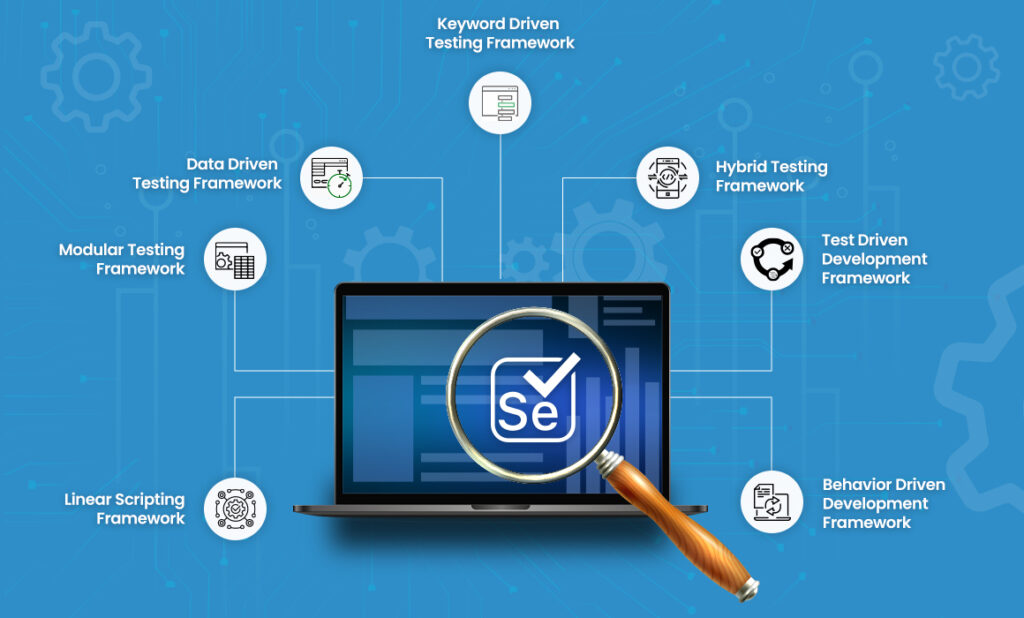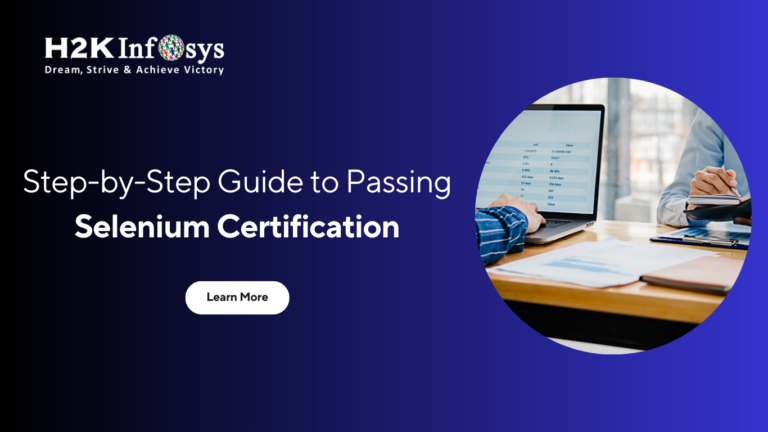Introduction
In the fast-paced world of software development and testing, automation is a key driver for efficiency and speed. Among the most popular tools for automation testing is Selenium, an open-source framework that helps developers and testers automate web applications. As automation testing continues to grow in importance, so does the demand for certified professionals proficient in tools like Selenium.
One way to demonstrate your expertise in Selenium is by earning a Selenium certification. This globally recognized credential can boost your career, prove your skills to employers, and open up more job opportunities in automation testing.

However, passing the Selenium certification exam isn’t a walk in the park. It requires not only theoretical knowledge but also hands-on practice and understanding of how Selenium works in real-world scenarios. But don’t worry we’ve got you covered. This step-by-step guide will take you through everything you need to know to successfully pass the Selenium certification and advance your career in automation testing.
Why Selenium Certification Matters
Before diving into the details of how to pass the exam, let’s take a moment to discuss why the Selenium certification exam is worth pursuing.
Increased Job Opportunities
In today’s competitive job market, having a Selenium certification on your resume is a great way to stand out. Automation testing is a critical skill in software development, and companies are always looking for skilled testers to ensure their applications are bug-free and perform smoothly.
According to a report from Statista, the number of job listings for automation testers using Selenium is steadily increasing, with demand expected to grow as more companies adopt DevOps and continuous integration practices. A certification proves that you have the skills necessary to meet these demands.
Demonstrates Expertise
By earning a Selenium certification, you showcase your deep understanding of the tool and its components. It shows that you can handle real-world challenges in automation testing, such as writing test scripts, running tests on multiple browsers, and identifying issues that arise during test automation.
This is an excellent way to demonstrate your practical experience to prospective employers.
Professional Growth
For individuals already working in the field of software testing, Selenium certification can lead to career advancement. Many companies encourage their employees to obtain certifications to increase their value in the marketplace. Whether you’re aiming for a promotion or looking to switch to a new organization, a Selenium certification will set you apart.
Preparing for the Selenium Certification Exam: A Step-by-Step Guide
Now that you understand why the Selenium certification exam is important, it’s time to focus on how to prepare for it. We’ve broken down the preparation process into clear steps that will help you study efficiently and maximize your chances of passing the exam.
Step 1: Understand the Exam Requirements
Before you begin studying, it’s essential to understand what the Selenium certification exam covers. While the exact syllabus can vary depending on the certification provider, most exams focus on the following topics:
- Selenium IDE (Integrated Development Environment): Basic understanding of the tool’s functionality and how it is used to create simple tests.
- WebDriver: Familiarity with WebDriver, the core component of Selenium that allows for interaction with web browsers programmatically.
- TestNG Framework: Knowledge of TestNG, a testing framework used in conjunction with Selenium for executing test cases.
- Locating Web Elements: Techniques for identifying web elements using locators like ID, name, class, and XPath.
- Handling Different Web Technologies: Interacting with different types of web technologies such as AJAX, JavaScript, and CSS.
- Automation Frameworks: Understanding how to design and implement robust automation frameworks.
Knowing the exam topics will guide your study sessions and help you focus on the right areas.
Step 2: Learn the Basics of Selenium
If you’re new to Selenium, it’s important to build a solid foundation before attempting the Selenium certification exam. Start by familiarizing yourself with the following core components:

- Selenium WebDriver: This is the most widely used component of Selenium, allowing you to automate browser interactions. Learn how to install WebDriver for different browsers (Chrome, Firefox, etc.) and interact with web elements (such as buttons, text fields, links, etc.).
- Selenium IDE: Selenium IDE is a browser extension that allows you to record and playback tests without writing code. While it’s not as powerful as WebDriver, it’s a great tool for beginners to understand the basics of Selenium.
- Selenium Grid: This component allows you to run tests on multiple machines and browsers in parallel, speeding up your test execution time.
Step 3: Dive Deeper into Selenium WebDriver
Once you’ve grasped the basics, it’s time to dive deeper into Selenium WebDriver. This is where the bulk of your preparation will take place. Focus on advanced concepts like handling alerts, frames, multiple windows, and dynamic elements. Learn how to implement waits efficiently, work with different browser drivers, and integrate Selenium with testing frameworks like TestNG or JUnit. Practical hands-on experience will significantly enhance your understanding.
Here’s a breakdown of essential topics you should study under Selenium WebDriver:
- Browser Interactions: Learn how to interact with different browsers using WebDriver (Chrome, Firefox, etc.). Study how to open a browser, maximize it, refresh the page, and perform basic actions like clicking buttons and typing text into input fields.
- Element Locators: Selenium offers several ways to locate elements on a web page, such as:
- ID: The most commonly used locator.
- Name: Useful for identifying input fields.
- XPath: A powerful locator method for navigating the DOM (Document Object Model).
- CSS Selectors: A more flexible option for identifying elements based on CSS attributes.
- Handling Web Elements: Learn how to interact with web elements, including checkboxes, dropdowns, radio buttons, and more. Be sure to understand how to handle pop-ups, alerts, and window switching.
Step 4: Master TestNG and Framework Design
While Selenium is powerful on its own, TestNG is a testing framework commonly used alongside Selenium. It allows you to organize and execute test cases in a structured manner. Key concepts to study include:
- TestNG Annotations: Learn how to use annotations such as
@Test,@BeforeSuite,@AfterClass, and others to define test flow. - Assertions: Master how to use assertions to validate expected outcomes in your test cases.
- Data-Driven Testing: Learn how to feed different sets of data into your tests to run them with various input values.
Additionally, familiarize yourself with designing automation frameworks. Frameworks like Page Object Model (POM) or Keyword-Driven are widely used to organize tests, reduce code duplication, and improve maintainability.
Step 5: Hands-On Practice
The most important step in preparing for the Selenium certification exam is to gain hands-on experience. Practical knowledge is crucial for passing the exam. Here are some tips for effective hands-on practice:
- Create Projects: Start by automating small projects, such as login forms or shopping cart tests. This will help you apply the concepts you’ve learned.
- Explore Real-World Scenarios: Try automating more complex scenarios, such as handling dynamic web elements, switching between multiple tabs, or working with databases.
- Test Across Browsers: Selenium supports multiple browsers. Make sure to practice running tests across different browsers to ensure compatibility.
You can find various practice exercises and sample projects on GitHub, online coding platforms, or in Selenium-related forums.
Step 6: Take Practice Tests
Once you’ve mastered the fundamentals and completed hands-on practice, it’s time to test your knowledge. Many certification providers offer practice exams that simulate the actual test environment. These mock tests are a great way to identify areas where you might be lacking and improve before the actual exam.
Step 7: Review and Final Preparations
Before sitting for the Selenium certification exam, review all the topics thoroughly. Focus on areas that you find challenging and make sure you’re comfortable with every concept. Go through the official documentation, practice writing test scripts, and understand various Selenium commands and locators. Work on real-world scenarios and debug errors to strengthen your problem-solving skills. Take mock tests, review past questions, and manage your time effectively. Stay updated with the latest Selenium features and best practices.
Here are some final preparations to keep in mind:
- Check the Exam Format: Understand whether the exam will be multiple-choice, practical, or a combination of both.
- Time Management: Practice answering questions within the time limit. Being aware of time constraints will help you stay calm and focused during the exam.
Conclusion
Passing the Selenium certification exam is an achievable goal if you follow a structured study plan and gain hands-on experience. Selenium is one of the most sought-after skills in the software testing world, and certification can be the key to unlocking new job opportunities and advancing your career.
By mastering Selenium, practicing coding exercises, and reviewing the exam topics, you’ll be well on your way to earning your certification and becoming a proficient Selenium automation tester.
Key Takeaways
- Understand the exam requirements before starting your preparation.
- Master Selenium WebDriver and the associated tools like TestNG.
- Gain hands-on experience by automating real-world projects.
- Take practice exams and review concepts regularly.
Ready to kickstart your journey to passing the Selenium certification? Enroll in H2K Infosys Selenium course today to gain practical, hands-on learning and boost your career prospects in automation testing!
























